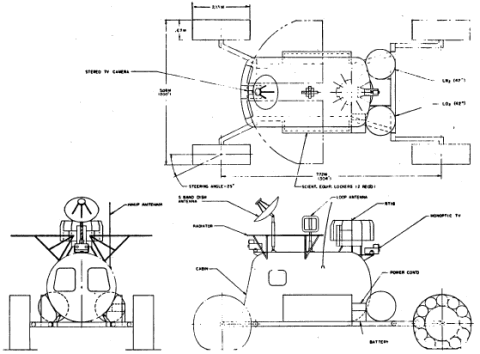
Home - Search - Browse - Alphabetic Index: 0- 1- 2- 3- 4- 5- 6- 7- 8- 9
A- B- C- D- E- F- G- H- I- J- K- L- M- N- O- P- Q- R- S- T- U- V- W- X- Y- Z
MOBEV R1DE

MOBEV R1DE
Status: Study 1966. Gross mass: 1,935 kg (4,265 lb).
The vehicle was delivered by a LM-Truck and was designed for up to six months of lunar storage prior to commencement of the mission. Prior to the crew's arrival, the vehicle was remotely unloaded and driven to the site of the astronaut's landing. The vehicle's mission was to provide three 48-hr sorties, and three 8-hr sorties during the 14 days the crew was on the moon. The range per sortie was 125 km per 48-hr sortie, and 40 km per 8-hr sortie. The vehicle carried a 320 kg scientific payload, and had an average speed of 8 km/hr.
The cabin was a basic semimonocoque pressure shell. A large front viewing window was located in the cabin full-length hinged door, and two side windows were also provided to enhance astronaut visibility. The astronaut seat incorporated a restraint system. The basic control and display pedestal was attached to the exit door, permitting unobstructed entry and exit from the cabin.
The power subsystem consisted of a 650-W RTG and an AgCd battery. The battery provided for peak power demands above the RTG output, and was recharged by the RTG during periods of low power requirements. Thermal control of the vehicle during the lunar storage phase was provided by the onboard RTG. The power subsystem selection was based on LSSM vehicle evolutions, packaging considerations, and extended capability.
The mobility subsystem consisted of four individually driven and suspended metal-elastic wheels. The drive motors and transmissions were hub mounted. Steering was accomplished by actuators in the front wheels.
The major elements of the life support subsystem were the crew provisions and the Environmental Control System (ECS). The crew provisions included equipment and expendables associated with the personal needs of the astronaut. The ECS provided pressurization, atmosphere control, cabin and suit temperature control, humidity control, contaminant control, and water management.
The astrionics subsystem was comprised of the communication, navigation, television, and illumination equipment. The communications equipment provided for S-band communications between the vehicle and earth, and for local lunar communications at VHF between the vehicle and the shelter, EVA astronaut, or other lunar terminals. The navigation equipment provided dead-reckoning computation with an accuracy of 1 km after traveling 50 km. The television equipment included a television camera providing a forward-looking stereo pair.
R1DE Cabin LSSM Lunar Station Vehicle
- Delivered Mass (kg): 1724
- Scientific Payload (kg): 320
- Crew Supplied Mass (kg): 69
- Total Operating Mass (kg): 1935
- Number of Sorties/Range (km): 3/500
- Average Maximum Speed (km/hr): 8
- Obstacle (cm): 62
- Development Cost ($M): 164.0
- Development Time (Mos.): 40
Crew Size: 1.
Family: Lunar Rovers, Moon. Country: USA. Agency: NASA, Bendix.
 | MOBEV R1DE |
Back to top of page
Home - Search - Browse - Alphabetic Index: 0- 1- 2- 3- 4- 5- 6- 7- 8- 9
A- B- C- D- E- F- G- H- I- J- K- L- M- N- O- P- Q- R- S- T- U- V- W- X- Y- Z
© 1997-2019 Mark Wade - Contact
© / Conditions for Use